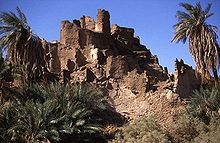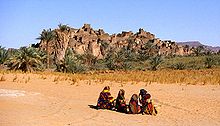Djado
| Rural municipality of Djado | ||
|---|---|---|
|
|
||
| Coordinates | 21 ° 1 ′ N , 12 ° 19 ′ E | |
| Basic data | ||
| Country | Niger | |
| Agadez | ||
| department | Bilma | |
| ISO 3166-2 | NE-1 | |
| Residents | 876 (2012) | |
Djado is a rural municipality in the department of Bilma in Niger . The actual settlement Djado is a ruined and ghost town .
geography
Djado is a Oasenort in the northeast of the Sahara counting Ténéré - desert , on the southwestern edge of the plateau of Djado . The rural community of Djado is both the furthest north and the furthest east in Niger. It borders in the north on the neighboring states of Algeria and Libya and in the east on the neighboring state of Chad . The neighboring communities in Niger are Dirkou in the south and Gougaram and Iférouane in the west. The rural municipality of Djado consists of the four administrative villages Chirfa (208 inhabitants), Orida (47 inhabitants), Séguédine (485 inhabitants) and Yaba (196 inhabitants). The main town of the rural community is the administrative village of Chirfa.
Almost around the rocky hill of ruins of Djado, which ends in steep cliffs in the west, there are pools fed by underground springs, ideal breeding grounds for mosquitoes . However, some of the ponds dry out almost completely in certain times of the year. In a southerly direction from Djado you can reach the Kaouar Valley . To the west it goes through the gravel desert of the Ténéré into the Aïr Mountains.
history
Djado is said to have been founded by the Sao , following the tradition of the indigenous Kanuri , to whom the founding of Tedjerhe in southern Fessan , the oldest locality of the Kaouar and the important urban culture of the Kotoko south of Lake Chad, can be ascribed. The urban character of Djados and the name continue to associate the village with Djado in Jabal Nafusa southwest of Tripoli . These two characteristics seem to indicate similarities with the sedentary Berbers . At least since the rule of Dunama Dibalemi (1203-1243) Djado was integrated into the Sefuwa empire of Kanem-Bornu . After a temporary independence, the inhabitants again submitted to the rule of the Sefuwa at the time of Idris Alauma (1564–1596). This king himself traveled with his army through the desert via Fachi to Bilma , 260 km south of Djado .
Due to the dwindling power of the Bornure Empire, the inhabitants of the oasis were exposed to numerous Tuareg raids in the 18th and 19th centuries . So they slowly left the place and settled in the Kaouar. Another reason for leaving the village is assumed to be the malaria mosquito introduced by cattle herds . Around a thousand Kanuri are said to have lived in Djado around 1860. In the middle of the 20th century, the place was only inhabited by a few Kanuri and Tubu . The salt production and the cultivation of the date groves were the main sources of income. In 1988 the Dakar rally passed through Djado.
population
At the 2001 census, Djado had 936 inhabitants. At the 2012 census, the population was 876. At the time of the date harvest, Tubu regularly stay near the ghost town. In the east of the municipality the Tubu language Tedaga and Libyan Arabic are common, in the northwest on the border with Algeria the Tamascheq - variety Tahaggart .
Culture and sights
The Djado Plateau and Fort was added to the tentative list of UNESCO World Heritage Sites on May 26, 2006 due to its universal cultural significance .
A few years ago the German travel journalist Uwe George discovered a Christian chapel in the ruins of Djado. George found the remains of a plastered cross, which he identified as a crucifix . Similar signs of the cross (croix d'Agadès) can be found among the Tuareg and in this case, too, one often assumes a Christian origin. On closer inspection, George and the archaeologist Helmut Ziegert also uncovered the rough sculpture of a blessing Christ and a container with the relic of a heart in the chapel. Christian influences did not reach the inhabitants of the central Sahara from Nubia , as George assumes, but via the Fessan , where Christianity was introduced in the 6th century AD under the rule of Byzantium . Also noteworthy are the remains of a castle on the highest point of the village and the remains of a dead house in the area of the city's cemetery.
See also
literature
- Jean Chapelle: Nomades noirs du Sahara . Paris 1957.
- Uwe George: The Citadel of Forgotten Christians . In: GEO , 1992, No. 9, pp. 157-182.
- Oumarou Amadou Idé: Préhistoire du Djado. Le paleolithique moyen de Yat . Mémoire de maîtrise. Faculté des Lettres et Sciences Humaines, Université de Niamey, Niamey 1991.
- Dierk Lange: A Sudanic Chronicle: the Borno Expeditions of Idris Alauma (1564-1576) . Stuttgart 1987.
- Albert Le Rouvreur: Une oasis au Niger. Le Djado . L'Harmattan, Paris 1999, ISBN 2-7384-7860-3 .
Web links
Individual evidence
- ^ Répertoire National des Communes (RENACOM) . Institut National de la Statistique website, accessed November 8, 2010.
- ^ Republic of Niger: Loi n ° 2002-014 du 11 JUIN 2002 portant création des communes et fixant le nom de leurs chefs-lieux .
- ↑ Dakar Retrospective 1979–2007. (PDF) Amaury Sport Organization, archived from the original on July 8, 2011 ; accessed on February 14, 2018 (English).
- ^ Institut Nationale de la Statistique du Niger (ed.): Annuaire statistique des cinquante ans d'indépendance du Niger . Niamey 2010 ( online version ; PDF; 3.1 MB), p. 53.
- ↑ Presentation of the results globaux définitifs du Quatrième (4ème) Recensement Général de la Population et de l'Habitat (RGP / H) de 2012. (PDF file) Institut National de la Statistique, 2014, accessed on April 18, 2014 (French ).
- ↑ Niger map. In: Ethnologue: Languages of the World. Seventeenth edition. SIL International, 2013, accessed July 18, 2013 .
- ^ Plateau et Fortin du Djado - UNESCO World Heritage Center


